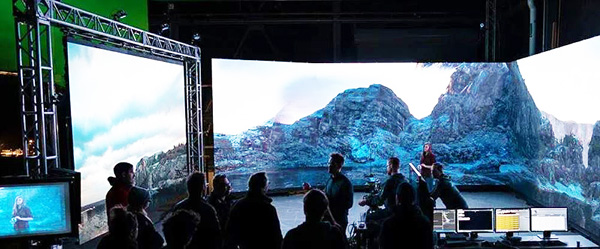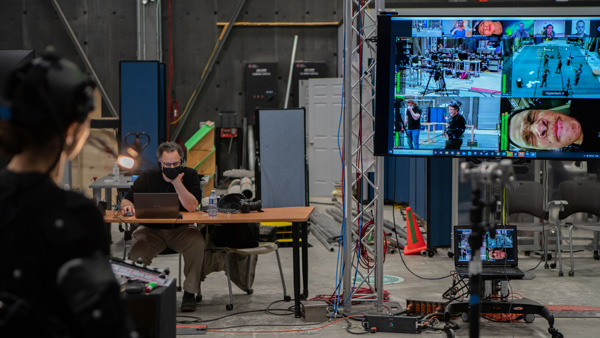
Sheridan College’s Screen Industries Research and Training (SIRT) Centre has built a new Virtual Production Innovation Hub that aims to help the industry shift to remote virtual production in response to the pandemic.
Located in Toronto, Sheridan College established SIRT in 2009 as a destination for training, collaboration and creation for screen production. SIRT focuses on innovation in digital image capture and creative processes for the film, television and gaming industries. The Virtual Production Innovation Hub was built at Pinewood Toronto Studios as part of SIRT’s production studio and lab facility.
LED Wall Compatibility
SIRT recently purchased an URSA Mini Pro 12K as the main camera for recording talent performing in front of the hub’s 40ft x 11ft LED wall. “We tested the compatibility of the shutter speed of several cameras with the LED wall, and the URSA Mini Pro 12K worked exceptionally well. It was able to deal with moiré and scan lines much better than the others,” said Kevin Santos, SIRT’s Junior Film Production Specialist.

“We selected the camera for its high resolution and high dynamic range as well, and the fact that it is made to integrate easily with DaVinci Resolve Studio, since we use Resolve throughout the rest of our pipeline. We find its editing experience straightforward and natural to work with, and now with the URSA Mini Pro 12K, production flows directly into post.”
Working with the LED wall, the virtual production pipeline is based on the URSA Mini Pro 12K and nine Micro Studio Camera 4Ks paired with Video Assist 3G monitor/recorders, which are fed into five HyperDeck Studio Pro recorders and an ATEM Television Studio Pro 4K live production switcher. The ATEM Television Studio Pro 4K’s program out is then fed directly into a computer using a DeckLink Studio 4K capture and playback card, which allows SIRT to work with most live streaming platforms.
Monitoring and Connections
The team also uses a MultiView 16 monitor to view all of the HyperDeck Studio Pro feeds at once, two SmartView 4K and SmartView Duo monitors, and a range of Micro Converters HDMI to SDI models and Mini Converters SDI Distribution 4K. The SDI Distribution 4K converters connect to multiple SDI devices – a single SDI source can be connected to eight re-clocked SDI outputs with automatic switching between SDI video formats up to 6G, plus ASI, ancillary and embedded audio formats.

SIRT Production Lead Jason Hunter said their goal is to give production team members a chance to contribute their input while still adhering to COVID-19 regulations. “Our system is designed so that people who can’t be here in person can still have a direct, flexible viewing experience, as well as to allow those who are present to communicate effectively,” he said.
“By creating this remote virtual production workflow – the Blackmagic Design cameras feeding into the HyperDeck Studio Pros and ATEM Television Studio Pro 4K – we’re able to record all of our different feeds individually to give to our clients, and at the same time carry out real-time switching to an audience. This ability is especially important for our virtual production work – our priority is getting as close to the final image as possible in-camera.”
SIRT has a staff limit now at their stage facility, which means that creatives can't all occupy the space at the same time. With the current set-up, they are able to stream the ATEM program feed to the client's video conferencing system as an alternative for real-time direction and feedback. “It’s really cool when a key creative can see what's happening live and see how it's being processed in real time, even while not in the room,” Jason noted.
Removing Barriers

SIRT’s Virtual Production Lead Spencer Idenouye said, “We truly believe that virtual production is going to change the film production landscape. However, we also understand that the financial barrier to entry is quite high. Through the new Virtual Production Innovation Hub, we want to create opportunities for everyone to try this workflow. Blackmagic Design manufactures a lot of the key components we need to not only record the content, but also establish reliability between our backend systems.”
He also said that, as a research institute, SIRT respects how Blackmagic Design tries new approaches and, in that way, disrupts the status quo. Along with its work with the Virtual Production Innovation Hub, the Centre uses its Blackmagic Design gear to create training and demo videos, record research sessions and other projects. “We facilitate creative problem solving in many forms, from testing new systems to upgrading workflows, developing tools for content creators within various industries as they evolve,” Spencer said.
“Building this infrastructure with their devices and hardware components has resulted in a pipeline supporting convenient, time efficient workflows. These may relate to virtual production or to our other research areas across digital cinema, virtual and augmented reality, remote collaboration and others.” www.blackmagicdesign.com




